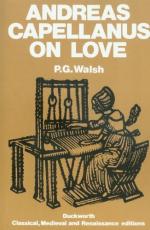|
This section contains 9,252 words (approx. 31 pages at 300 words per page) |

|
SOURCE: “Juan Ruiz and Andreas Capellanus,” in Hispanic Review, Vol. 40, No. 4, Autumn, 1972, pp.390-411.
In the following essay, Clarke describes how Ruiz's Libro de buen amor satirizes De Amore.
Two works important in early Romance literature and known by virtually identical titles that mask similar but opposite deceits are the Archpriest Juan Ruiz's Libro de buen amor1 of the early half of the fourteenth century, and Andreas Capellanus's breviary on courtly love now commonly referred to as De arte honeste amandi,2 of approximately a century-and-a-half earlier. Although Juan Ruiz selects his title professedly to honor his bawd (st. 933), his title, like the work itself, has several layers of meaning: on the surface having to do with the troubadours' fin' amor, an idealized type of love constantly refined by unconsummated physical desire, and opposed to fol' amor ( loco amor), lust; below the surface containing other meanings, among them travestied...
|
This section contains 9,252 words (approx. 31 pages at 300 words per page) |

|


